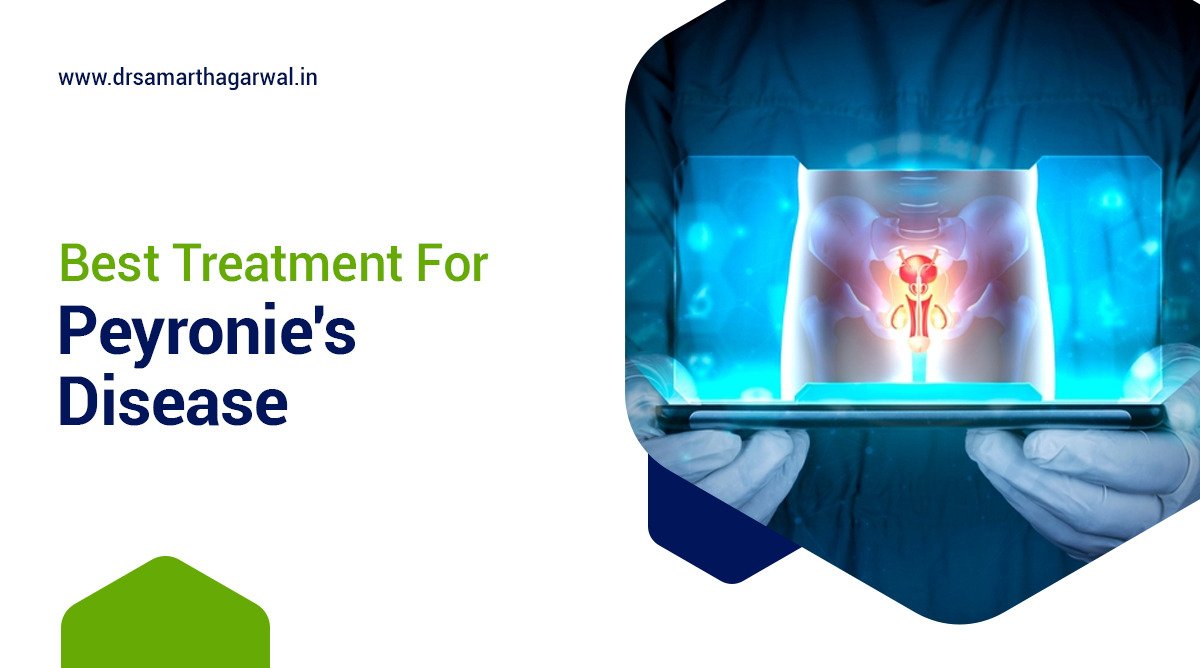Peyronie’s disease is a chronic and painful condition that is characterized by fibrotic stiffening of the penis. The management of this disease involves a variety of options including surgical and non-surgical treatments.
The treatment selection based on the severity of the disease, the overall health of the patient, and their preferences plays a crucial role in achieving the best outcomes. Here are a range of treatment options for Peyronie’s disease in the most recent literature, focusing on various surgical and non-surgical treatments.
Among the new surgical methods, the major developments are angioplasty of the penis for the elimination of the plaque and revascularization of the penis through a subdermal approach, as well as improvements in various surgical techniques for penis reconstruction and culmination surgery.
On the other hand, radiation therapy, siltendra, vitamin E, shockwave and anti-inflammatory treatments are effective tools in treating the non-surgical aspects of Peyronie’s disease.
According to a 2023 research paper published in the International Journal of Environmental Research and Public Health by Dr. Hasan Beyari, the following key information was found:
Peyronie’s disease (PD) is a condition that affects up to 9.6% of men, and penile deformity, not the plaque, is the main complaint of a PD patient. For selected cases, surgical treatment should focus on functional penile length restoration, as patients with PD are likely to have experienced a decrease in penile length due to the curvature. The geometrical technique is the most precise procedure for lengthening the short side, thereby recovering the length lost to scarring. Maximum length restoration was shown to be possible and limited by the length of the dissected neurovascular bundle. The preoperative evaluation includes a complete sexual and medical history, assessment of penile deformity, rigidity, vascular status, and arterial anomalies, as well as patient and partner satisfaction.
The preoperative evaluation should also establish the presence and severity of associated erectile dysfunction (ED), as the diameter and length of intracavernosal vessels may influence the surgical indications and outcomes. The presence of arterial anomalies, such as arterial insufficiency or veno-occlusive dysfunction, may require additional treatment, such as vascular reconstructive procedures or penile prosthesis implantation.
Once penile length and function have been assessed, the patient’s referral for surgery can be determined. A systematic approach to penile curvature correction, utilizing geometrical principles and proper patient selection, can lead to optimal outcomes for the patients.
What Are the Best Treatments for Peyronie’s Disease
The best treatments for Peyronie’s disease depend on the severity of your condition and your individual goals. There are generally two main approaches: nonsurgical and surgical.
Nonsurgical options are typically recommended during the early stages of Peyronie’s disease. These can include:
Medications
There are two main types of medications used for Peyronie’s disease: oral medications and injectable medications.
Oral medications, like pentoxifylline, have been used to improve blood flow and potentially reduce curvature, but research shows mixed results on their effectiveness.
Injectable medications target the scar tissue itself. Collagenase injections, like Xiaflex, are an FDA-approved option that can help break down the plaque. Other injectable medications, such as verapamil, are still being studied to determine their long-term benefits.
It’s important to note that medications are generally considered most effective in the early stages of Peyronie’s disease. Your urologist can help you decide if medications are the right course of treatment for you.
Injections
Collagenase clostridium histolyticum (Xiaflex) is the FDA-approved medicine for the treatment of Peyronie’s disease. Verapamil is another medicine that can be given as an injection and works by disrupting scar tissue and preventing further scar tissue from forming. There is no single gold standard injectable therapy for Peyronie’s disease and even the only FDA-approved injectable agent has shown mixed results. Xiaflex has been associated with serious injury to the penis in some cases. It’s important to note that there are different clinical trial results and resources for Peyronie’s disease treatment.
Traction therapy
Penile traction therapy emerges as a significant nonsurgical treatment that may aid in mitigating the penile curvature associated with this condition. This therapy involves the application of a device that exerts a stretching force on the penis, aiming to reduce curvature by remodeling the scar tissue.
Penile traction therapy finds its utility primarily in the chronic phase of Peyronie’s disease when the condition stabilizes. Health care professionals prescribe this therapy to patients as it may help straighten the penis and enhance erectile function without the need for invasive procedures.
Additionally, early treatment using penile traction devices can prevent further curvature progression and, in some cases, reduce the existing curve or bend in the penis.
The goal of combining penile traction with other nonsurgical or surgical interventions is to enhance penile straightness and function, reduce pain, and address any associated erectile dysfunction.
Surgery
If nonsurgical options aren’t effective or your Peyronie’s disease is causing significant sexual problems, surgery may be an option. There are different surgical procedures available, depending on the specific characteristics of your condition. These procedures aim to either straighten the penis by shortening the healthy tissue or by placing a patch (graft) on the plaque to allow for a more natural bend. In some cases, if Peyronie’s disease is accompanied by erectile dysfunction, a penile prosthesis implant may be recommended. This implant helps achieve and maintain an erection during intercourse.
According to Levine, Laurence A. and Larsen, Stephen M.’s 2013 article ‘Surgery for Peyronie’s disease’ published in the Asian Journal of Andrology, Peyronie’s disease (PD) is a fibrotic wound-healing disorder of the tunica albuginea that causes penile deformity and sexual dysfunction. Despite various non-surgical treatments, surgery remains the gold standard for correction of this condition. The authors discuss the preoperative evaluation, surgical algorithm, graft materials, and postoperative management of PD. They review the outcomes for tunical shortening, tunical lengthening, and penile prosthesis placement for penile straightening.
It’s important to discuss all these treatment options with a urologist to determine the most suitable approach for your specific needs.
How long does it take to cure Peyronie’s disease?
The duration required to cure Peyronie’s disease varies, primarily depending on the treatment approach and the disease stage. Early treatment often accelerates recovery, potentially reducing the timeline. Collagenase clostridium histolyticum, specifically approved for this condition, directly targets and breaks down the scar tissue formed during the acute phase, facilitating a quicker resolution.
Penile traction therapy, another method, aims to gradually diminish curvature and mitigate scar tissue’s impact, further contributing to a comprehensive recovery process. When these treatments commence during the acute phase, before scar tissue solidifies, the chance of full recovery improves significantly.
Therefore, while the exact timeframe can range from a few months to a year or more, engaging in early treatment with the right interventions like collagenase clostridium histolyticum and penile traction therapy can effectively reduce pain and restore functionality more swiftly.
You might also like: Complications of Hypospadias Surgery
Is it OK to live with Peyronie’s disease?
Living with Peyronie’s disease is feasible, especially since treatments can straighten the penis, and in some cases, the condition even goes away on its own. Various surgical methods, such as plication, graft, or penile implant, may be used to correct the curve or bend if the condition is getting worse or significantly affects erectile function. Non-surgical options aim to reduce pain and may prevent the disease from progressing. If the disease and erectile dysfunction coexist, interventions focus on enhancing the erect state and overall sexual health. Therefore, with appropriate management, the impact of Peyronie’s disease on one’s life can be minimized, making it entirely possible to live with the condition without severe compromise to quality of life.
How can I treat Peyronie’s disease at home?
Treating Peyronie’s disease at home focuses on managing symptoms during its acute phase and preventing progression. Oral medications, such as verapamil, may reduce plaque size and ease penile curvature. These drugs target the collagenase enzyme, breaking down scar tissue on the side of the penis. Another treatment, interferon injections, can decrease curvature and reduce pain by altering scar tissue properties.
For those seeking non-pharmacological options, penile traction devices aim to straighten the penis and may help restore length lost to Peyronie’s disease. Traction therapy, applied for several hours daily, gradually corrects penile curvature by stretching the penile tissue. This method proves most effective in the disease’s chronic phase, preventing further curvature and potentially improving erectile function.
Erectile dysfunction, a common Peyronie’s complication, benefits from specific oral medications that enhance erection quality, allowing men with Peyronie’s to maintain sexual activity. Importantly, these treatment options require patience and consistency, as improvements take time to manifest.
In cases where Peyronie’s disease progresses or penile curvature severely impedes sexual function, consulting a healthcare provider is essential. Professional interventions might include verapamil injections to break down plaque directly, or more invasive options like surgery to remove scar tissue or implant devices that straighten the penis.
However, such measures are considered only after evaluating the disease’s stability and the patient’s overall health. In summary, while at-home treatments offer significant benefits in managing Peyronie’s disease symptoms and progression, collaboration with healthcare professionals ensures the most suitable and effective approach.
You might also like: Aqua Therapy for Enlarged Prostate
What happens if Peyronie’s is left untreated?
If Peyronie’s disease goes untreated, the curvature of the erect penis may not improve and can get worse. The natural course of the condition means that, without treatment, some men will experience an increase in discomfort and a decrease in sexual function. Physicians may recommend early treatment to reduce pain and improve function, though some cases may stabilize or slightly improve without intervention. Nonsurgical options, like injections, aim to alleviate the condition’s symptoms without the need for surgery. However, for those with severe or worsening conditions, surgery might become necessary.
Procedures such as plication, grafting, or the insertion of a penile implant may be used to correct the curvature and restore sexual function. These types of surgery are considered when Peyronie’s disease significantly affects the quality of life and nonsurgical methods are insufficient in managing the condition. Without timely and appropriate treatment, individuals may face persistent symptoms and the potential exacerbation of penile deformity, underscoring the need for treatment evaluation in early stages.
Can you regain length after Peyronie’s?
Regaining length after Peyronie’s disease is possible through certain medical interventions. Scar tissue, which causes the penis to bend, can be addressed with methods aimed to straighten the penis. Initially, treatment may focus on nonsurgical options if the disease does not progress or goes away without treatment. However, when Peyronie’s disease persists or gets worse, causing significant curvature or pain, more direct methods may be used.
Penile traction devices and injectable treatments have shown to improve the condition by stretching the connective tissue inside the penis, potentially reducing the curvature and restoring some length. For more severe cases, surgical options such as plication, which involves removing or pinching a piece of the penile tissue to straighten the penis, or grafting, where scar tissue is replaced with a tissue called a graft, are effective. Additionally, a penile implant may be considered, especially in men who also experience erectile dysfunction.
A significant percent of men with Peyronie’s benefit from these treatments, although the choice of treatment depends on the severity of the condition and individual patient factors. It is crucial for individuals to seek medical advice early, as the success of treatments varies, and early intervention may prevent the condition from getting worse or reduce pain. Connective tissue disorders like Peyronie’s can often improve with targeted treatment, restoring both function and appearance to a degree that improves quality of life.
You might also like: Neurogenic Bladder Overactive Bladder Causes, Symptoms, Management
Is Peyronie’s Disease Permanent?
While Peyronie’s disease can result in curvature or pain in the penis, the symptoms may improve or even disappear naturally in some cases, especially if not severe.
Treatment options for Peyronie’s disease depend on the severity of the symptoms and how long the condition has been present. In many cases, treatment may not be necessary for a mild case of Peyronie’s disease. However, if symptoms are severe and causing significant distress, medications, physical therapy, or even surgery may be recommended.

Consult with Dr. Samarth Agarwal, Urologist at Siliguri.




